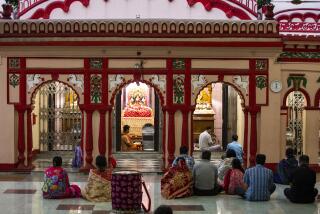Muslims -- India’s new ‘untouchables’
- Share via
The news of the attacks in Mumbai eerily took me back to a quiet morning two years ago when I sat in Room 721 of the Taj Mahal Palace & Tower hotel, reading the morning newspaper, fearing just the kind of violence that has now exploded in the city of my birth. The headlines recounted how the socioeconomic condition of the people of my ancestry, Muslims in India, had fallen below that of the Hindu caste traditionally called “untouchables,” according to a government report.
“Muslims are India’s new untouchables,” I said sadly to my mother, in the room with me. “India is going to explode if it doesn’t take care of them.” Now, indeed, alas it has. And shattered in the process is the myth of India’s thriving secular democracy.
Mumbai police said over the weekend that the only gunman they’d captured during the attacks -- which left nearly 200 dead and more than 300 wounded -- claimed to belong to a Pakistani militant group. But even if the trouble was imported, the violence will most certainly turn a spotlight of suspicion on Muslims in India. Already, my relatives are hunkered down for a sectarian backlash they expect from anti-terrorism agencies, police and angry Hindu fundamentalists.
India, long championed as a model of pluralism, used to be an example of how Muslims can coexist and thrive even as a minority population. My extended family prospered as part of an educated, middle class. My parents, who settled in the United States in the 1960s when my father pursued a doctorate at Rutgers University, were part of India’s successful diaspora. I love India, and on that trip, I wanted to show it off to my son, Shibli, then age 4.
But on that visit, across India from Mumbai to the southern state of Tamil Nadu and north to Lucknow, the hub of Muslim culture, I was deeply saddened. Talking to vegetable vendors, artisans and businessmen, I heard about how the condition of Muslims had deteriorated. They had become largely disenfranchised, poor, jobless and uneducated. Their tales echoed those I’d heard on previous trips, when my extended family recounted their humiliating experiences with bureaucratic, housing, job and educational discrimination.
Indeed, the government report I read about in the newspapers two years ago acknowledged that Muslims in India had become “backward.” “Fearing for their security,” the report said, “Muslims are increasingly resorting to living in ghettos around the country.” Branding of Muslims as anti-national, terrorists and agents of Pakistan “has a depressing effect on their psyche,” the report said, noting Muslims live in “a sense of despair and suspicion.”
According to the report, produced by a committee led by a former Indian chief justice, Rajender Sachar, Muslims were now worse off than the Dalit caste, or those called untouchables. Some 52% of Muslim men were unemployed, compared with 47% of Dalit men. Among Muslim women, 91% were unemployed, compared with 77% of Dalit women. Almost half of Muslims over the age of 46 couldn’t read or write. While making up 11% of the population, Muslims accounted for 40% of India’s prison population. Meanwhile, they held less than 5% of government jobs.
The Sachar committee report recommended creating a commission to remedy the systemic discrimination and promote affirmative-action programs. So far, very few of the recommendations have been put in place.
Since reading the report, I have feared that Islamic militancy would be born out of such despair. Even if last week’s terrorist plot was hatched outside India, a cycle of sectarian violence could break out in the country and push some disenfranchised Muslim youth to join militant groups using hot-button issues like Israel and Kashmir as inspiration.
What has irked me these last years is how the world has glossed over India’s problems. In 2006, for instance, former U.S. Defense Secretary William Cohen, whose Cohen Group invests heavily in India, said the U.S. and India were “perfect partners” because of their “multiethnic and secular democracies.” When I asked to interview Cohen about the socioeconomic condition of Muslims, his public relations staffer said that conversation was too “in the weeds.” But, to me, the condition of Muslims needs frank and open discussion if there is to be any hope of stemming Islamic radicalism and realizing true secular democracy in the country.
India’s 150 million Muslims represent the second-largest Muslim population in the world, smaller only than Indonesia’s 190 million Muslims. That is just bigger than Pakistan’s 140 million Muslims or the entire population of Arab Muslims, which numbers about 140 million. U.S. intelligence reports continually warn that economic, social and political discontent are catalysts for radicalism, so we would be naive to continue to ignore this potential threat to the national security of not just India but the United States.
Throughout my 2006 journey, I found the idea of India’s potential for danger unavoidable. On one leg, my son tucked safely in bed with my mother in our Taj hotel room, I went out to watch the filming of “A Mighty Heart,” the movie about the murder of Wall Street Journal reporter Daniel Pearl by Muslim militants in Pakistan. When the location scouts needed to replicate the treacherous streets of Karachi’s militant Islamist culture, they didn’t have to go far. They found the perfect spot in a poor Muslim neighborhood of Mumbai.
Asra Q. Nomani is the author of “Standing Alone: An American Woman’s Struggle for the Soul of Islam.”
More to Read
Sign up for Essential California
The most important California stories and recommendations in your inbox every morning.
You may occasionally receive promotional content from the Los Angeles Times.













